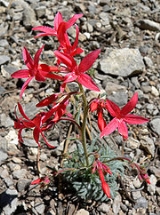
Ipomopsis arizonica
Encyclopedia
Ipomopsis arizonica is a flowering plant
in the family Polemoniaceae
, native to the mountains of the Mojave Desert
sky island
s from southeastern California
east through southern Nevada
to northern Arizona
, growing at 1500-3100 meters altitude. It is found in rocky places in the desert, as well as washes.
perennial plant
, dying after flowering and producing seeds. It grows from 10-30 cm tall, with pinnately lobed leaves
3-5 cm long with 7-11 lobes. The flower
s are produced 5-13 on a one-sided spike, each flower tubular, 1 to 2 centimeters long, with five corolla lobes each up to a centimeter long; they are bright red, and pollinated by hummingbirds.
Flowering plant
The flowering plants , also known as Angiospermae or Magnoliophyta, are the most diverse group of land plants. Angiosperms are seed-producing plants like the gymnosperms and can be distinguished from the gymnosperms by a series of synapomorphies...
in the family Polemoniaceae
Polemoniaceae
Polemoniaceae are a family of about 25 genera with 270-400 species of annual and perennial plants, native to the Northern Hemisphere and South America, with the center of diversity in western North America, especially in California.Only one genus is found in Europe, and two in Asia, where they...
, native to the mountains of the Mojave Desert
Mojave Desert
The Mojave Desert occupies a significant portion of southeastern California and smaller parts of central California, southern Nevada, southwestern Utah and northwestern Arizona, in the United States...
sky island
Sky island
Sky islands are mountains that are isolated by surrounding lowlands of a dramatically different environment, a situation which, in combination with the altitudinal zonation of ecosystems, has significant implications for natural habitats. Endemism, vertical migration, and relict populations are...
s from southeastern California
California
California is a state located on the West Coast of the United States. It is by far the most populous U.S. state, and the third-largest by land area...
east through southern Nevada
Nevada
Nevada is a state in the western, mountain west, and southwestern regions of the United States. With an area of and a population of about 2.7 million, it is the 7th-largest and 35th-most populous state. Over two-thirds of Nevada's people live in the Las Vegas metropolitan area, which contains its...
to northern Arizona
Northern Arizona
Northern Arizona is an unofficial, colloquially-defined region of the U.S. state of Arizona. It is dominated by the Colorado Plateau, the southern border of which in Arizona is called the Mogollon Rim. In the West lies the Grand Canyon, which was cut by the flow of the Colorado River while the...
, growing at 1500-3100 meters altitude. It is found in rocky places in the desert, as well as washes.
Description
Ipomopsis arizonica is a monocarpic herbaceousHerbaceous
A herbaceous plant is a plant that has leaves and stems that die down at the end of the growing season to the soil level. They have no persistent woody stem above ground...
perennial plant
Perennial plant
A perennial plant or simply perennial is a plant that lives for more than two years. The term is often used to differentiate a plant from shorter lived annuals and biennials. The term is sometimes misused by commercial gardeners or horticulturalists to describe only herbaceous perennials...
, dying after flowering and producing seeds. It grows from 10-30 cm tall, with pinnately lobed leaves
Leaf
A leaf is an organ of a vascular plant, as defined in botanical terms, and in particular in plant morphology. Foliage is a mass noun that refers to leaves as a feature of plants....
3-5 cm long with 7-11 lobes. The flower
Flower
A flower, sometimes known as a bloom or blossom, is the reproductive structure found in flowering plants . The biological function of a flower is to effect reproduction, usually by providing a mechanism for the union of sperm with eggs...
s are produced 5-13 on a one-sided spike, each flower tubular, 1 to 2 centimeters long, with five corolla lobes each up to a centimeter long; they are bright red, and pollinated by hummingbirds.

